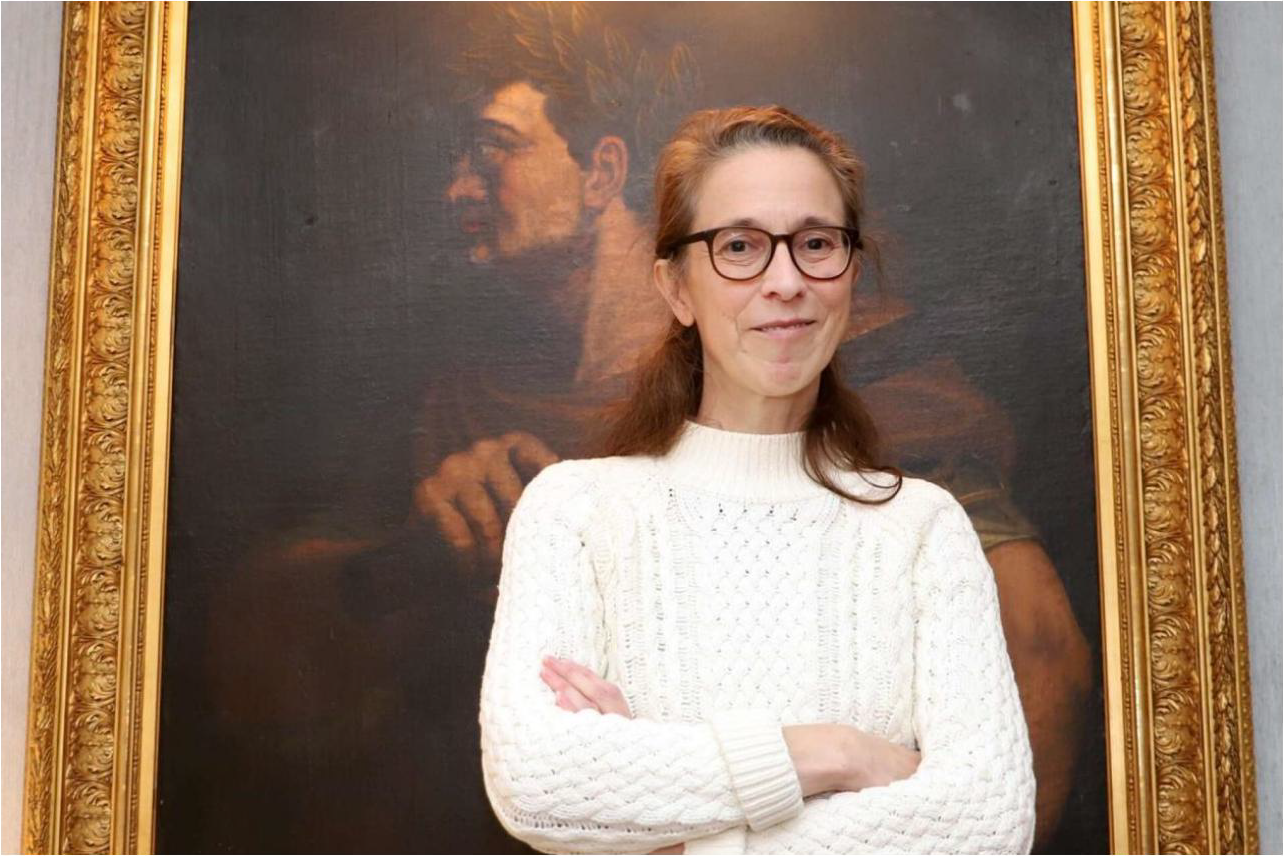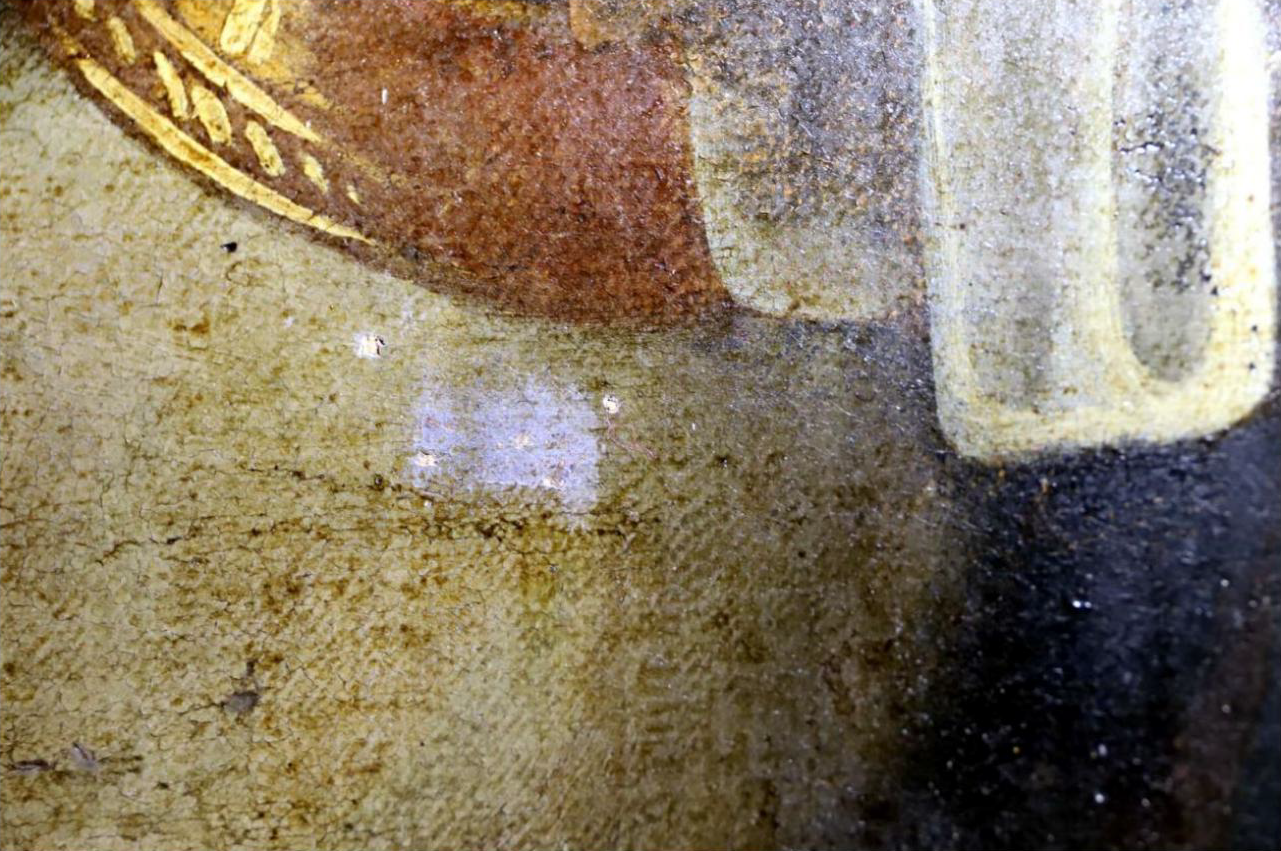On a return visit to the emperor – that’s how the siblings’ inherited mystery has turned out
PUBLISHED: 2024-03-16 10:00 AM

Lena Richardson
lena.richardson@nwt.se

A group of siblings inherited a painting with a powerful motif and a heartpounding signature.
The NWT told us about it just over a year ago. Now we go on a return visit to the emperor – and find two siblings who feel the solution to his great mystery approaching.
– There is still nothing to contradict the fact that the signature was there from the beginning.
We start with a summary. When NWT visited the siblings in an apartment somewhere in Värmland, it was to look at the massive oil painting they inherited from their grandfather.
He bought the large portrait at an auction in Arvika in the late 1930s, probably after receiving a tip from a friend. The painting in the solid gold frame then hung for all the years in the buyer’s home. The children in the house called him ”uncle with the stick”.
”It doesn’t work that way”
Now we make a big jump in time, to the mid-90s. One of the now grown-up grandchildren shines a strong lamp on the painting and discovers a faint signature in a dark area in the left corner of the painting. The name makes the heart flutter: it says ”L da Vinci” and below the letters ”Pinxt”. Wow!

– We had no idea how many details there were around the painting and what significance those details had. We thought three weeks after the signature was discovered that it was a done deal. But we soon discovered that it doesn’t work that way, says Karl when we meet again, a year after our first meeting.
Time speaks for the project
He is one of the siblings who inherited the painting and states that in the 90’s there was a cross stop. No expert showed much interest in their findings and the internet barely existed, so finding the facts themselves became difficult.
The project was put on hold, but the siblings did not forget the emperor and his riddle.
When new times came with new technology, they started researching seriously.

In the fall of 2022, NWT readers got a first sneak peek at the artwork. Then analyzes had shown that the painting is really from the turn of the century 1400-1500 – da Vinci’s time. And the motif is the Roman emperor Domitian.
The research continued
Since the last visit, the painting has had to move to a new, also secret address, but above all, the siblings’ research project has continued.

The emperor has been involved in quite a few adventures: he has been X-rayed and photographed with infrared light. Cross-section and type of fabric have been analyzed. Raman analyzes have been done to see which substances were used in the colors, where the common pigments of the time were found, such as cinnabar and cerrusite, but also lapis lazuli, which at the time could be more expensive than gold.
– But also a lot of other interesting things, which we intend to publish in a scientific article.
An expert in Gothenburg and one in Stockholm have closely studied the painting and the siblings themselves have sat for hours and browsed the internet among images of drawings by da Vinci. They also regularly post new findings on an online project page.
How many hours a week do you actually spend on this?
– It goes a little in periods, depending on what kind of reports you get. Sometimes it can be a hundred hours and sometimes one, says Karl.

They have plowed a lot of money into the project, but above all time and energy.
– It is probably 350,000, at least, guesses Karl.
But is it a genuine da Vinci they have? Nobody knows. But:
– All the technical investigations we have done show one thing: that it is possible, says Maria. We have so much evidence. Every little helps!
Not contradicted
So far, however, nothing has come to light that technically contradicts that the signature is from the correct time. This is what a conservator who examined the painting writes:
”However, the part of the painting where the signature is located does not appear to have been retouched. This part is not changed, however the signature may have been painted on during a previous restoration or it may have been there before. Nothing speaks against that the signature has been there from the beginning. The signature is most certainly underneath the current varnish.”
– Yes, the research we have done in the last year has turned out to be such that there is still nothing that speaks against that the signature was there from the beginning, says Maria.

However, an expert review shows that the signature was almost washed away in a previous attempt to clean the painting.
The leaves have grown
The investigations have also shown that the painting has been improved in many ways over the years. The lips have been painted redder and the leaves now seen in the Emperor’s hair are painted on later.
– But on X-ray you can see the shape of some other leaves, which are much smaller in number. He had leaves from the beginning, but in a different form and much more sparingly. Now the whole head is covered in leaves! says Karl.
Popular Caesar paintings
After all the years with the research project, the siblings were not only familiar with technical concepts but also with art history, Habsburg emperors and English royal houses. For example, they can tell you that portraits of this kind were very fashionable in the 16th and 17th centuries.
The English king bought a series of emperor portraits and in the 17th century Queen Kristina took home a whole series to Sweden, one of which is a portrait depicting Domitian, a painting that is similar to the sibling’s and today can be found at Uppsala Castle.

Its popularity led to the painting of several series of emperor portraits, of which Titian painted the most famous.
– Titian’s original series is what counts, but one has not been 100% sure if he did all twelve, or if he only did eleven because there was already one, says Karl. Most experts seem to agree that Titian made eleven and that the twelfth is made by a different hand, says Karl. We feel a responsibility. If you find an object that has potential and is interesting for the story, then you have some kind of obligation to try to find out. — KarlThey think it is important to research the painting’s origins.
– We feel a responsibility. If you find an object that has potential and is interesting for the story, then you have some kind of obligation to try to find out. If you find a rock slab with a carving on it, you can shovel a pile of earth over it, for God’s sake it would be a pain if a lot of archaeologists come here and start digging, but the sense of responsibility means that you still have to try to take care of it and find out the facts, says Karl.
Do you think you are closer to the solution of the riddle today?
– Yes I think so. But we have to struggle with finances for the restoration, says Maria.
– But we also don’t want to wash everything off and make it like new. Then you have removed the imprint of history and the damage that has occurred, says Karl and reasons around a gentle restoration:
– In any case, a wash, where you take the first step and remove the dark varnish. And that you remove the obvious retouchings, such as the lips, which were added later, says Karl.
Scares the experts
Then more experts would dare to see the possibilities in the work, they believe.
– If you could get this restored, it would look completely different and then the art experts would also have something else to look at – if they can’t see through what is now and imagine what it would look like if it was already restored, says Karl.

At the same time, they understand if many experts are a little scared, after all the tours around the Salvator Mundi painting. It was sold as a newly discovered da Vinci for an astronomical SEK 3.8 billion, but international expertise continues to disagree about its authenticity.
– It’s exactly that crossing the threshold, where someone dares to put theirreputation on the line. That’s what it’s all about. In support, we can say that no one is really claiming anything, but we are just trying to present the facts. In the end, you may have obtained so many facts that you can still allow yourself to think that it might actually be true, says Maria.
How do you keep the spirit up in the project?
– It is actually kept up continuously, in that no information that appears contradicts it. It becomes more that you get two more possibilities: it can be this or that. Then we have to determine which of these two variants it is, says Maria.
– We find new things continuously. We have sat and looked at this painting for 35 or 40 years, and you find new things all the time, says Karl.

They have no other plans right now but to fight on. They would like to root further in English archives and consult international experts.
– There is no expertise in Sweden that can comment on this. But the next step is actually to get an expert to make a statement and then it is important to have all the technical evidence ready. We are almost there, says Karl.
Time for an exhibition?
They are also thinking about trying to find a museum that wants to exhibit the painting and also help with more research.

